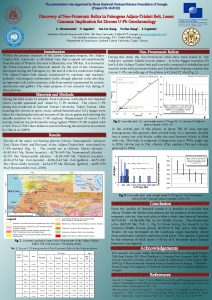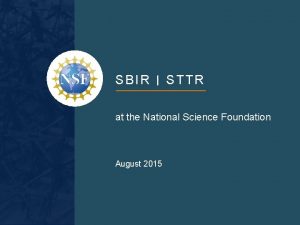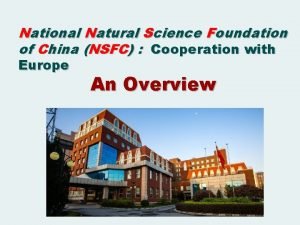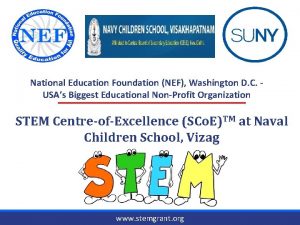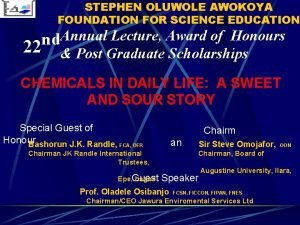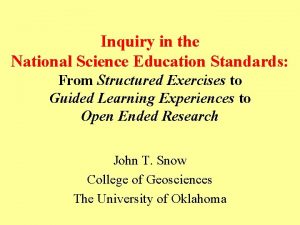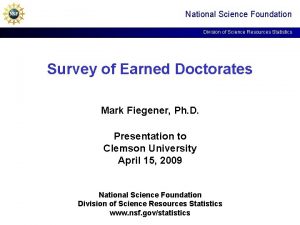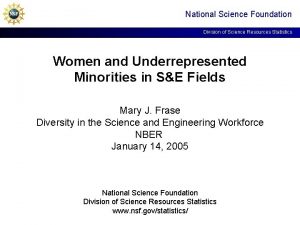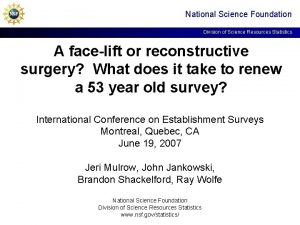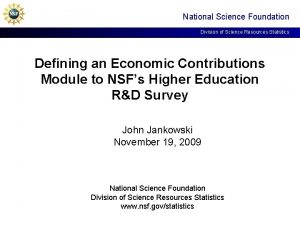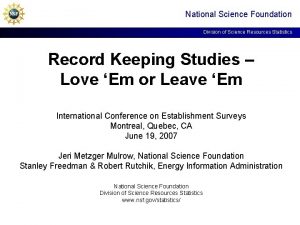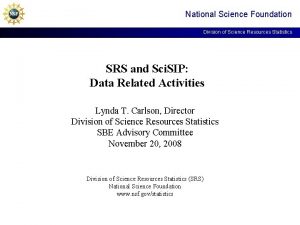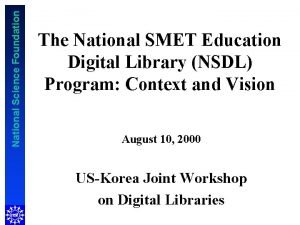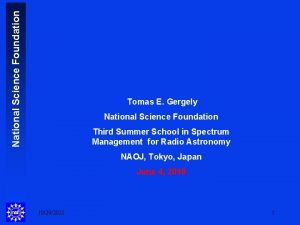National Science Foundation Division of Undergraduate Education DUE














- Slides: 14

National Science Foundation Division of Undergraduate Education (DUE) Section 2 Program Tracks Ellen M. Carpenter, Ph. D. Program Officer Division of Undergraduate Education (DUE) Education and Human Resources Directorate (EHR)

National Science Foundation Division of Undergraduate Education (DUE) IUSE: EHR Program Two Program Tracks Engaged Student Learning Focus on designing, developing, and implementing research on STEM learning models, approaches, and tools Two Tiers Institutional and Community Transformation Focus on increasing the propagation of highly effective methods of STEM teaching and learning Two Tiers Exploration & Design (smaller scale) Development & Implementation (larger scale) Exploration & Design (smaller scale) Up to $300 K Up to 3 yrs Level I: Up to $600 K, Up to 3 yrs Up to $300 K Up to 3 yrs Level II: $600 K to $2 M, Up to 5 yrs Development & Implementation (larger scale) Up to $3 M Up to 5 yrs

National Science Foundation Division of Undergraduate Education (DUE) Program Tracks Engaged Student Learning (ESL) • FOCUS: design, development, and research studies that involve creation, exploration, or implementation of tools and models that increase engagement of undergraduate students in STEM learning • EXPECTED PRODUCTS: resources that lead to measurable and lasting learning gains • COLLABORATIVE PROJECTS: collaborations among STEM disciplinary researchers, education researchers, and cognitive scientists are encouraged 3

National Science Foundation Division of Undergraduate Education (DUE) Program Tracks Engaged Student Learning (ESL) • INTENDED AUDIENCE: • Students at 2 - and 4 -year institutions • Declared and undeclared STEM majors • Students whose courses of study require solid skills and knowledge of STEM principles • Students completing general education requirements in STEM 4

National Science Foundation Division of Undergraduate Education (DUE) Program Tracks Engaged Student Learning (ESL) • Projects are expected to be evidence-based and knowledge-generating – Leveraging what is known about how people learn – Contributing to the body of knowledge in STEM learning 5

National Science Foundation Division of Undergraduate Education (DUE) Program Tracks Engaged Student Learning (ESL) • Disciplinary differences and priorities can lead to a range of possible approaches for engaged student learning. These may include, but are not limited to: ❖ Assessment/metrics of learning and practice ❖ Education research ❖ Faculty professional development ❖ Learning environments ❖ Co-curricular activities to increase motivation and/or persistence 6

National Science Foundation Division of Undergraduate Education (DUE) Program Tracks Engaged Student Learning (ESL) • ESL projects can lead to a variety of outcomes, including (but not limited to): ❖ Development of STEM and STEM-related workforces ❖ Advancing the disciplinary field ❖ Broadening participation in STEM ❖ Educating a STEM-literate populace ❖ Improving K-12 STEM education through undergraduate preservice STEM teacher preparation ❖ Building capacity in higher education 7

National Science Foundation Division of Undergraduate Education (DUE) Program Tracks Engaged Student Learning (ESL) • Proposals for ESL projects should: – demonstrate a solid grounding in relevant literature on STEM teaching and learning – include an evaluation plan that provides formative and summative assessment of the effectiveness of the project in achieving its goals 8

National Science Foundation Division of Undergraduate Education (DUE) Program Tracks Institutional and Community Transformation (ICT) • The ICT track supports projects that use innovative approaches to increase use of evidence-based STEM teaching and learning practices as well as curricular, and co-curricular practices across or within disciplinary communities • Projects may be proposed by an institution or group of institutions • Community proposals may be submitted through professional communities, including discipline-based professional societies and networks or organizations that represent institutions of higher education • Projects are expected to be both evidence-based and knowledgegenerating 9

National Science Foundation Division of Undergraduate Education (DUE) Program Tracks Institutional and Community Transformation (ICT) • Competitive ICT proposals pertaining to institutional and community transformation should: – Include a description of theory of change that is guiding the proposed work – Test hypotheses about transforming undergraduate teaching and learning in STEM by examining the impact of deliberate processes of change • It is recommended that theories of change include a description of plan to develop information about problem to be addressed, goals to be achieved by project, as well as processes, interventions, or strategies that will enable the proposing institution or community to meet those goals • Proposals should be informed by relevant research literature and theoretical perspectives concerning change 10

National Science Foundation Division of Undergraduate Education (DUE) Program Tracks Institutional and Community Transformation (ICT) • Promising proposals will recognize that STEM higher education is a complex system, and that achieving change goals involves analyzing and addressing the relevance and impact of critical organizational factors (for example, faculty reward systems) that could impede or facilitate progress toward goals • ICT proposals that review favorably recognize that support from key administrative leaders, ranging from presidents and provosts, to deans and department chairs, is an important factor in affecting development, impact, and sustainability of change efforts at the institutional level. 11

National Science Foundation Division of Undergraduate Education (DUE) Program Tracks Institutional and Community Transformation (ICT) • Applicants may apply for ICT grants to engage in planning efforts, starting with research or surveys on how to increase the value accorded to evidencebased instruction within institution • Projects may focus on whole institutions, on departments or colleges within an institution, or on networks or groups of institutions. • Projects may seek to transform high-enrollment, lower division courses or may implement efforts in multiple courses within a department or college, or in a particular disciplinary area at multiple institutions. 12

National Science Foundation Division of Undergraduate Education (DUE) Program Tracks Institutional and Community Transformation (ICT) • Projects may include many elements, such as: – The use of technology and distance education methods (or hybrid designs) when supported by evidence of potential effectiveness – Faculty learning through professional development or leadership development for pedagogical and curricular innovation • Competitive ICT proposals should include an evaluation plan that provides formative feedback to guide development of project and summative assessment of the effectiveness of the project in achieving its goals • Plans for dissemination of tools to communities should be included 13

National Science Foundation Division of Undergraduate Education (DUE) This concludes the section on Program Tracks
 Shota rustaveli national science foundation
Shota rustaveli national science foundation Nsf sbir program directors
Nsf sbir program directors National nature science foundation of china
National nature science foundation of china National education foundation nef
National education foundation nef Stephen oluwole awokoya foundation for science education
Stephen oluwole awokoya foundation for science education National science education standards inquiry
National science education standards inquiry My favourite subject is english because
My favourite subject is english because Figura con 4 lati
Figura con 4 lati Liberty chapter 20
Liberty chapter 20 Grande rhetra
Grande rhetra Principio di conservazione della quantità di moto
Principio di conservazione della quantità di moto Shallow pad foundation
Shallow pad foundation Composition of urine
Composition of urine Undergraduate meaninh
Undergraduate meaninh Portland state university undergraduate tuition and fees
Portland state university undergraduate tuition and fees
